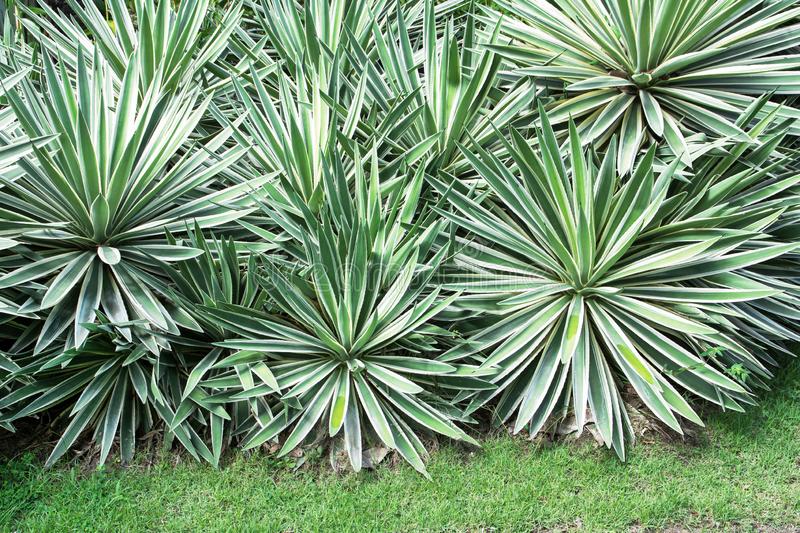Sisal Fiber
Sisal fiber is derived from leaves of plant. It is usually obtained by machine decortications. The strands are usually creamy white, average from 80-120 cm in length and 0.2 -0.4 mm in diameter and are lustrous in appearance. The World production is about 3000,000 tons, Brazil being the largest producer followed by China, Mexico, Tanzania, Kenya and Madagascar. Sisal is a member of the agave family; Agave Sisalana is the commercially grown species. The plants grow for 7 to 12 years and then produce a flower stalk 4 to 6 meters tall and die. Sisal is a xerophytic plant and thus it can grow in dry climates but it will not grow sufficiently in poorly drained soil. The life of sisal plant is usually 15-18 years. Sisal is generally harvested once a year but if the soil and the climate permits it can harvested three times in two years.

Physical Properties of Sisal Fibers
- Length 2.88 mm
- Width 22.6 pm
- Tenacity 57.2 cN/Tex
- Elongation 3.02%
- Moisture regain 13%
Features of Sisal fibers
In natural fibers, the flaws or weak links are irregularly spaced in the fiber; the strength will depend on the length of the fiber used for the tensile test.
Sisal fiber tensile strength and percentage elongation decrease with increase in test length and Young's Modulus and average modulus increase with test length. When speed of testing increases the Young's Modulus and tensile strength increases.
Sisal fibers are smooth, straight and yellow in color. Sisal is fairly coarse and inflexible so the sisal fiber can be long or short.
Sisal is valued for cordage use because of its strength, durability, ability to stretch, affinity for certain dyestuffs, and resistance to deterioration in saltwater.
Manufacturing Process of Sisal Fiber
Sisal fiber made from the process of Decortication, leaves are crushed and beaten by a rotating wheel set with blunt knives, so that only fibers remain. The other parts of the leaf are washed away by water. Decorticated fibers are washed before drying the sun or by hot air. The fiber quality depends upon moisture content so proper drying is important. To get better grades of fiber artificial drying has been found in place of sun drying. Dry fibers are machine combed and sorted into various grades, largely on the basis of the previous in-field separation of leaves into size groups.
A sisal fiber in cross-section is built up of about 100 fiber cells. Figure The cell walls consist of several layers of fibrillar. In the primary wall, the fibrillar have a reticulated structure. In the outer secondary wall , which is located inside the primary wall, the fibrillar are arranged in spirals with a spiral angle of 40° (for sisal fiber) in relation to the cell. The fibrillar in the inner secondary wall of sisal fibers have a sharper slope, 18° to 25°. The thin, innermost, tertiary wall has a parallel fibrillar structure and encloses the lumen. The fibrillar are, in turn, built up of microfibrillar with a thickness of about 20µm. The microfibrillar are composed of cellulose molecular chains with a thickness of 0.7µm and a length of a few µm
Applications of Sisal
The short sisal fiber, with its features of softness, high-flexibility, high friction resisting, acid resisting and alkali resisting, it is an excellent material of High-quality sofa, Wadding mat Pulp Constructing materials
The plants can be also used as an effective hedge to protect crops and land from predators, and the extensive root system helps to reduce soil erosion in arid areas.
Other sisal materials include Rope Sisal core for steel wire rope, Yarn and twine, Sisal cloth Polishing , buff Carpet Pulp ,Constructing materials and doormats

Grades Of Sisal Fiber
Grade UG
Grade SSUG
Grade Tow
Grade 3L
Sisal Ropes
Our Branches In Morocco
- Mohammedia
- Marrakesh
- Agadir
Our Contract Agreement With
- Agro Group Kenya
- Metl Group Tanzania
Our Supporters
- Royal Star Shipping Tanzania
- Diamond Shipping Kenya
- Sea Roshak IRAN
- Eagle Of Sea Shipping Co. Iran
- Royal Shipping Mumbai
- CM Logistics Kochi
- CM Logistics Chennai
